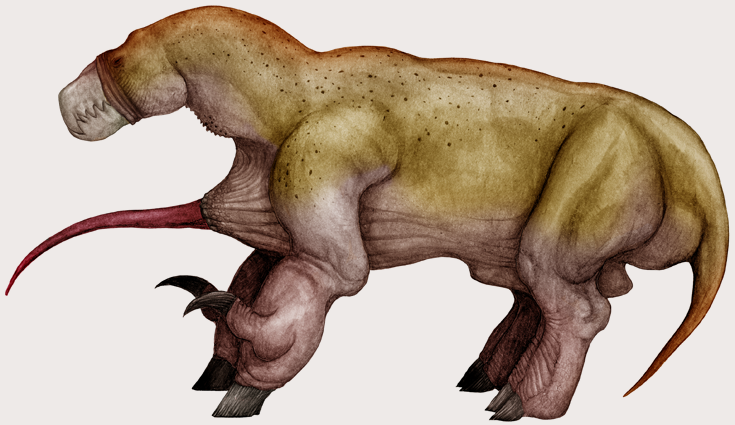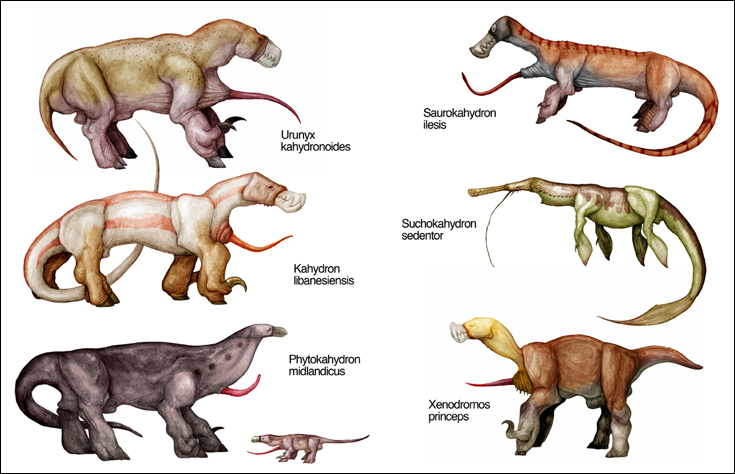Kahydroniformes
Smart and powerful, Kahydrons (along with the Fututors,) are some of the most successful and widespread predatory animals on Snaiad. The defining characteristics of these creatures are their characteristic hoof-and-claw forelimbs and an innovative adaptation that gives them a hydraulic bite on their first-head jaws. Like most other Snaiadi “vertebrates,” Kahydrons have dual series of hydraulic muscles that serve to flex and move their backbones and first-head necks. These organs resemble interlocking chains of connected water balloons jacketed in tough protective cases of muscle, fat and gristle. In almost all other advanced “vertebrates,” these chains end at the base of the first-head. In Kahydrons, an offshoot of the hydraulic chain juts into the “cheek” region of the first head, enabling it to bite down with extreme pressure. As a result, Kahydrons can crack open bones, bite through their prey’s tough hydraulic muscles and defend themselves against other predators.
Kahydroniformes are a very diverse group and have macropredators, scavengers, omnivores, herbivores and even swimmers within their ranks. They are also some of the smartest creatures on Snaiad; Kahydrons have larger and tighter brain clusters in comparison to other animals their size, and some species can even hunt cooperatively.

Species: Kahydron libansiensis
Common Names: Kahydron, Lebanese Kahydron, Greater Kahydron.
Size: 2.5 meters long.
Habitat: Sprogland, forest, pinnacle range and scrubland habitats across Isterna.
The so called “lions of Lebanon”, these predators are a common sight around the human settlements across the Neomediterranean. Like all Kahydrons they have powerful jaws with extensive hydraulic musculature, which, along with their extendable killing claws, have given them a decisive edge in hunting. The Greater Kahydron is noteworthy for its pack hunting behavior, long, whip like tail and red stripes. With several related species, it is classified as a Magnodont Kahydroniform, the dominant clade of large-game hunters on mainland Snaiad.
As chief predators, these animals invariably come into conflict with Fututors, especially the Baroclavid Arbophobos mavrikaulos. With the extermination of the latter from the Neomediterranean area, the numbers of Greater Kahydrons have risen even more around human settlements. Fortunately, they rarely attack people and even seem to have the potential for domestication. Recent experiments with taming these creatures have mixed results, but seem promising if the animals are raised from infancy.

Species: Saurokahydron ilesis
Common Name: Hazzal.
Size: 1.5-3 meters long.
Habitat: Southern Neomediterranean shores, also occurs in the Ankyranian desert.
While the public image of these creatures is different, not all Kahydrons are powerful macropredators. In fact, a great majority of Kahydroniform species fill a similar role to weasels, stoats and badgers on the bygone Earth; living secluded lives in thickets, burrows or pinnacle ranges and hunting smaller animals. Such creatures are classified (albeit problematically and certainly artificially,) in a common group, the Saurdont Kahydroniformes.
Saurokahydron ilesis is one of the largest Saurodonts, growing up to three meters or even more. It lives principally among the Erythrophyte maquis around the southern Neomediterranean, stalking prey in the undergrowth. Although large, it is perfectly camouflaged with a skin as reddish as the plants it lives among. Unlike its larger cousins, Saurokahydron does not have enlarged killing claws and snaps up its prey with rapid lunges of its elongated first head instead. It also hunts extensively at night, and has puffy white, enlarged heat receptors around eyes for this purpose.
A distinct, pale and smaller population of S. ilesis inhabits the Ankyranian desert. Although the desert and the seashore populations can produce viable offspring, these two groups might be classified as distinct species in the future. These animals are known as Hazzals on Snaiad, and beautiful, especially lean and dark-skinned women are likened to them as an adjective of beauty.

Species: Urunyx kahydronoides
Common Names: Shortface Kahydron, Forest Kahydron.
Size: 4,5-5 meters long.
Habitat: Forests across the Vesternian Alps, Lower and High Pontic Alps, also found in the Pontic forests.
With its short, crushing bite and long, scythe-like claws, this hulking Kahyron looks like a terrifying predator at first sight. Indeed, it does kill and eat some of the large forest browsers from time to time, but the majority of Urunyx’ diet is made up of forest fruit and plants. That it is a part-time vegetarian, however, does not mean that Urunyx is incapable of defending itself. In the vast Pontic forests, even the deadly Baroclavus Fututors give them a wide berth for fear of their claws, one swipe of which can easily disembowel any potential attacker.
Urunyx belongs to the divergent Allodont Kahydroniformes, a group of Kahydrons notable for their distinct jaw arrangement, free-swinging shoulders and unique foot structure. Although this group includes placid omnivores like Urunyx, it also contains fearsome, bulldog-like predators such as Pinchers (Stratognathos sp.)

Species: Phytokahydron midlandicus
Common Names: Herbidon, Gray Grazer.
Size: 2 meters.
Habitat: A variety of regions in the Midland continent.
Some Kahydroniformes such as Urunyx occasionally take vegetation, but only this species among the entire group feeds exclusively on vegetation. As juveniles, specimens of Phytokahydron look remarkably similar to the yapping, meat-eating offspring of other Kahydroniformes, with a first-head beak adapted for biting and sharp hoof-claws. As they grow up, juvenile Phytokahydrons gradually switch to fruit, leaves and finally tough vegetative material such as sprog, bark or even Erythrophytes. These plants are cropped and chewed with a beak that grows more ridges and acquires grinding surfaces as the years pass. The chewed mass is then passed down to a specially developed sac in the first head, getting even more tenderized among stones “swallowed” for the purpose. Finally, the whole mass is regurgitated and siphoned by a very long “tongue” into the second head, where Snaiadi animals have their true stomachs. This “fake stomach” is unique among Snaiadi animals to this genus. When pregnant, female Phytokahydrons cannot use this arrangement for feeding, and must be fed by attentive males.
This creature is the only extant species of Phytokahydron on Snaiad, and is not, as one might expect, a result of isolated evolution on Midland. Fossil evidence reveals that the appearance of Phytokahydron predates the isolation of Midland from Isterna, and rather than acting as a crucible, Midland has actually been a lifeboat for these remarkable herbivores.

Species: Suchokahydron sedentor
Common Name: Crochydron.
Size: Up to 5 meters, but usually less, including tail.
Habitat: Rivers in the Azonic Jungle.
Deep inside the Azonic Jungle lurks a wonder of adaptive radiation. Looking every bit like a twisted crocodile, this strange animal is actually a highly derived, aquatic Kahydron. Although fairly large, it is an extremely secretive hunter, snatching up small aquatic organisms with its Gharial-like jaws while taking care to avoid vicious Amazonian Motor-Crocodiles it shares its habitat with. Unlike the Motosuchids, the Crocahydron has no form of jet propulsion; it swims with lateral undulations of its broad tail. Paddles derived from the strong, erect limbs of its ancestors help with stability and can carry the animal on land with surprising efficiency if need has it. Never too common, Crochydrons are protected with captive breeding programs in order to preserve the legacy of their evolutionary adventure.

Species: Xenodromos princeps
Common Name: Howlrunner
Size: 2 meters.
Habitat: Sprogland plains in Notor
They may look superficially alike, but this group of running predators is so different from other Kahydroniformes that Snaiadi zoologists see them a sister group to other Kahydrons, or even a completely different branch of predatory animals that has independently evolved Kahydroniform-like adaptations such as hydraulic bites. Unlike all other Kahydrons, their rear feet have a single toe, the tail is nearly absent and the anatomy of their limbs has been heavily modified for a running lifestyle. They also lack the gular pouch used by most other Kahydrons to gestate their young. Instead, the young of Xenodromoids develop in a strange sac that extends into the chest from the base of the first head, giving them the characteristic weird, “string-necked” look.
Whatever they are, Howlrunners live by running down fast prey on the endless temperate plains of Notor. There are more than seven recognized species, including dainty forest hunters (Allodaphne sp.) and thick-set tundra runners (Vaöphobos sp.)
Copyright laws protect all intellectual property associated with Snaiad.
All artwork, concepts and names associated with this project belong to C. M. Kosemen, unless otherwise stated.
